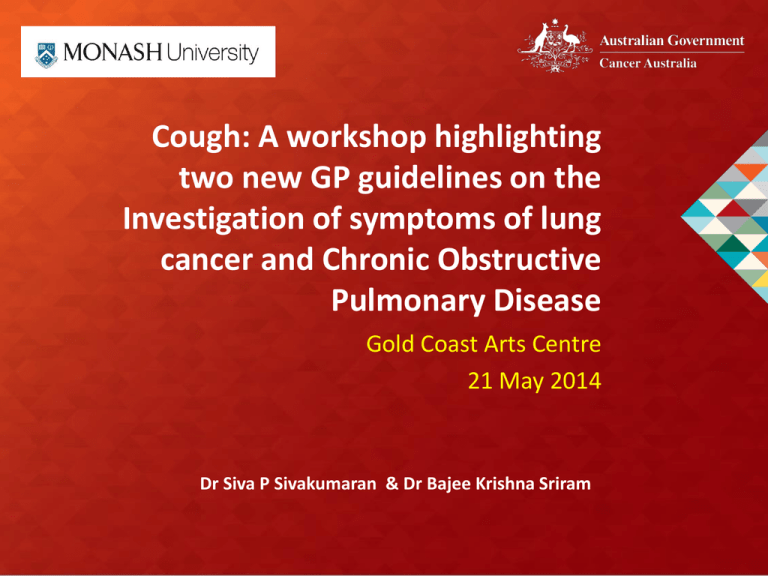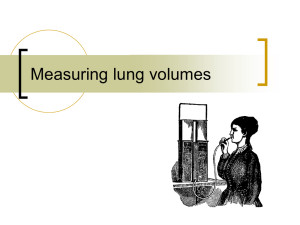
Cough: A workshop highlighting
two new GP guidelines on the
Investigation of symptoms of lung
cancer and Chronic Obstructive
Pulmonary Disease
Gold Coast Arts Centre
21 May 2014
Dr Siva P Sivakumaran & Dr Bajee Krishna Sriram
Investigating symptoms of lung
cancer: a guide for GPs
General practitioner workshop
Dr Siva P Sivakumaran
MBBS, MRCP (UK), FRACP, FCCP
Medical Director, Respiratory Medicine
Gold Coast University Hospital
Learning objectives
Demonstrate knowledge of:
Best practice assessment of patients who may have lung
cancer
Risk factors for lung cancer and symptoms that may indicate
lung cancer
Early and rapid referral into the cancer care pathway and
why it is important for patient outcomes
The importance and role of multidisciplinary teams
Lung cancer – context
More deaths than breast, prostate and
ovarian cancers combined
5-year relative survival is only 14% but
this is higher for early stages of lung
cancer
Variation in survival in early stages may
be due to variation in referral and
treatment offered
http://www.uscreates.com/
Diagnosis
Stage
Description
Treatment options
Localised
Only one lobe of the lung is affected.
Surgery and/or radiotherapy
Regional
The tumour has spread through the
wall to surrounding organs and tissues
and/or to nearby lymph nodes.
Surgery & radiotherapy
(+/- adjuvant chemotherapy)
increases survival
Distant
metastases
The cancer cells have spread to distant
parts of the body, such as the bones or
liver.
Palliative radiotherapy to improve quality of life
and increase survival
Unknown
Insufficient evidence to assign a stage.
Adapted from: 1. Cancer Council Vic. Diagnosing lung cancer. 2013 and 2. Cancer Council. Clinical practice guidelines for the treatment of lung cancer
(2013) Cancer Australia, 3. Australian Institute of Health and Welfare & Cancer Australia 2011. Lung cancer in Australia: an overview. Cancer series no. 64.
Cat. no. CAN 58. Canberra: AIHW.
Treatment opportunities
All patients with lung cancer should be seen by a lung cancer
specialist to discuss options for treatment, palliation or surveillance.
Options include:
–
–
–
–
–
Surgery – usually a lobectomy or pneumonectomy
Chemotherapy
Radiotherapy
Targeted treatment – EGFR mutation
Supportive care
Clinical practice guidelines for the treatment of lung cancer –
Cancer Council Australia and Cancer Australia (released Nov 2012)
– Recommendations for Stage 1 to 4
http://wiki.cancer.org.au/australia/Guidelines:Lung_cancer
Ref: Peter Mac. Lung cancer treatments. www.petermac.org/LungCancerTreatments
Survival at diagnosis
Five year relative survival by stage at diagnosis, New South
Wales 1999-20031
New South Wales 1999-2003
Stage at diagnosis*
Number of
cases
% of staged cases Relative survival
(%)
Localised
3,272
31.6
29.8
Regional
2,582
24.9
18.7
Distant
4,504
43.5
3.1
Unknown
3,266
31.6
9.3
Total
13,624
100.0
14.0
Reference: 1 Australian Institute of Health and Welfare & Cancer Australia 2011. Lung cancer in Australia: an overview.
Cancer series no. 64. Cat. no. CAN 58. Canberra: AIHW.
Survival by stage
One-Year Relative Survival (%) by Stage, Adults 15-99
Prepared by Cancer Research UK
Original data source:
The National Cancer Registration Service, Eastern Office. Personal communication.
http://ecric.org.uk/
Survival by stage
Five -Year Relative Survival (%) by Stage, Adults 15-99
Stage IV survival could not be calculated at five years due to the small number of people surviving more than two years.
Prepared by Cancer Research UK
Original data source:
The National Cancer Registration Service, Eastern Office. Personal communication.
http://ecric.org.uk/
Lung cancer in General Practice
Patients with symptoms of lung cancer may present
with symptoms to GPs first
Symptoms often present as part of routine primary
care or during the management of other diseases
e.g. COPD, chronic heart failure and coronary heart
disease
Symptoms are often non-specific
The average full time GP may see only one lung
cancer patient every 1-2 years
The GP Guide
Questions addressed:
Symptoms & signs of lung cancer: What are the
symptoms or combinations of symptoms & signs
that are likely to indicate lung cancer?
Investigations: Which investigations are effective in
diagnosing a patient with suspected lung cancer?
Referral: Effective investigation and referral of
suspected lung cancer – red flags, referral
pathways.
Development of the Guide
Development of the Guide was overseen by an Expert
Advisory Panel
ADAPTE process for guideline adaptation
Recommendations adapted from:
– Suspected cancer in primary care: guidelines for
investigation, referral and reducing ethnic disparities.
New Zealand Guidelines Group 2009
– The diagnosis and treatment of lung cancer. National
Institute of Clinical Excellence (NICE) 2011
– Diagnosis and management of lung cancer. American
College of Chest Physicians 2007
The GP Guide
An evidence
report supports
the 2 page
summary
http://canceraustralia.gov.au/publications-and-resources/cancer-australia-publications/evidence-relevant-guide-investigation-symptoms
The Guide
Lung cancer in Australia
Lung cancer is the fourth most commonly diagnosed
invasive cancer in Australia
Lung cancer is the leading cause of cancer death in Australia
Lung cancer incidence is strongly related to age
Tobacco smoking is the largest single cause of lung cancer
Aboriginal and Torres Strait Islander people are 1.7 times as
likely to be diagnosed with lung cancer as non-indigenous
people
Risk factors
lifestyle factors:
tobacco smoking,
former tobacco smoking
environmental factors
passive smoking
radon in homes
occupational exposure, e.g.
previous exposure to
asbestos, diesel exhaust
air pollution
personal factors
age
family history of lung cancer
smoking-related chronic
obstructive pulmonary
disease
previous lung diseases
history of cancer, especially
head and neck cancer
1
6
The Guide
Recommendations to facilitate referral and patient support
Ensure referrals are timely & provide relevant / detailed
information to the specialist
Provide the patient with information that clearly describes:
–
–
–
–
where they are being referred
who they will see
what they can expect from the specialty service
the expected timeframes
Advise patient to carry all previous imaging
Advise patient to stop smoking and offer therapies to assist
Ensure the patient’s need for continuing support is addressed
Share appropriate information between healthcare professionals
Symptoms and signs of lung cancer
Any of the following unexplained, persistent symptoms and signs lasting
more than 3 weeks (or less in people with known risk factors):
Symptoms
Signs
Unexplained haemoptysis
Abnormal chest signs
New or changed cough
Finger clubbing
Chest and/or shoulder pain
Cervical &/or supraclavicular
lymphadenopathy
Shortness of breath
Features suggestive of metastasis from a
lung cancer
Hoarseness
Signs of pleural effusion
Weight loss/loss of appetite
Unresolved chest infection
Case study 1
Case study 2
Case study 2
Case study 3
Consolidation consistent with the clinical picture
Image to be included here
Case study 3
Case study 3
Case study 3
Referral pathways
Recommendation: Refer a patient to a specialist linked to a lung cancer
multidisciplinary team (MDT)
Multidisciplinary care is the best practice approach to
providing evidence-based cancer care
It involves a team approach to cancer care, improving
survival and quality of life
MDTs exist across Australia and provide the mechanism to
improve patient care, outcomes and address variations in
care
Aboriginal Health Workers provide a critical link for
Aboriginal and Torres Strait Islander people, in providing
information, support and service co-ordination
Referral pathways
Recommendation: Refer a patient to a specialist linked to a lung cancer
multidisciplinary team (MDT)
A lung cancer MDT may
include:
–
–
–
–
–
–
–
–
–
surgeons
GPs
respiratory physicians
oncologists
pathologists
radiologists
specialist nurses
psychological services
allied health and palliative
care services
Functions of a lung
cancer MDT:
– diagnoses and staging
– selecting and carrying out
optimal treatments
– managing symptoms and
side effects
– providing support to
manage patient wellbeing
or other concerns
Engaging with multidisciplinary teams
What happens before and after the meeting?
GP refers their patient to a specialist who is a
member of a multidisciplinary team
the GP is invited to attend the meeting (options for
tele-link are often available)
if a GP cannot attend the meeting, a summary of
discussions is sent to the GP, or can be requested
after the meeting
Tasmania http://directory.cancersupportcentre.org.au
Queensland https://qccat.health.qld.gov.au/DOCS#
GP Barriers to implementation
Doubt that earlier intervention makes a difference
“Please give us data about
earlier diagnosis and
survival…not just diagnosing 6
months earlier so they appear
to live for 6 months longer”
GP Barriers to implementation
Infrequency of lung cancer in practice
“It is a real challenge to expect the
existence of a guideline to be
remembered…about a condition that the
average GP will diagnose…based on
reasonable evidence, only once every
two years.”
General comments from GPs about guidelines
for lung cancer
Doubt that there is a need to re X-ray adults with pneumonia
“I never understood the
rationale for exposing all
post-pneumonia patients
to more radiation after
they have already
recovered.”
Medical Procedure Dose
Procedure
Dose (millirem)
X-Rays-single exposure
Pelvis
70
Abdomen
60
Chest
10
Dental
1.5
Hand/Foot
0.5
Mammogram (2 views)
72
Nuclear Medicine
400
CT Scan
Full body
1,000
Chest
700
Head
200
US Nuclear regulatory commission
http://www.nrc.gov/about-nrc/radiation/around-us/doses-daily-lives.html
The GP Guide – Key take home messages
Be aware of lung cancer risk factors in your patients and
community
Early recognition of symptoms and signs is critical
3 week window for unexplained persistent symptoms
X-ray is the first line of investigation
Chest CT is the second line of investigation
Referral to a lung cancer multidisciplinary team (MDT)
Other sources of information about the GP guide
Investigating the symptoms of lung cancer – a Qstream
course for GPs
– Category 2 points with RACGP
– 30 planned reflective development points with ACCRM
http://cl-wedg.qstream.com/wedgcollaboration/courses/3373Investigating-the-symptoms-of-lung-cancer-A-Qstream-course-for-GPs
Investigating the symptoms of lung cancer – an Active
Learning Module with RACGP
– 6 Category 2 points with RACGP
– Soon to be released on the gplearning RACGP website
www.canceraustralia.gov.au









